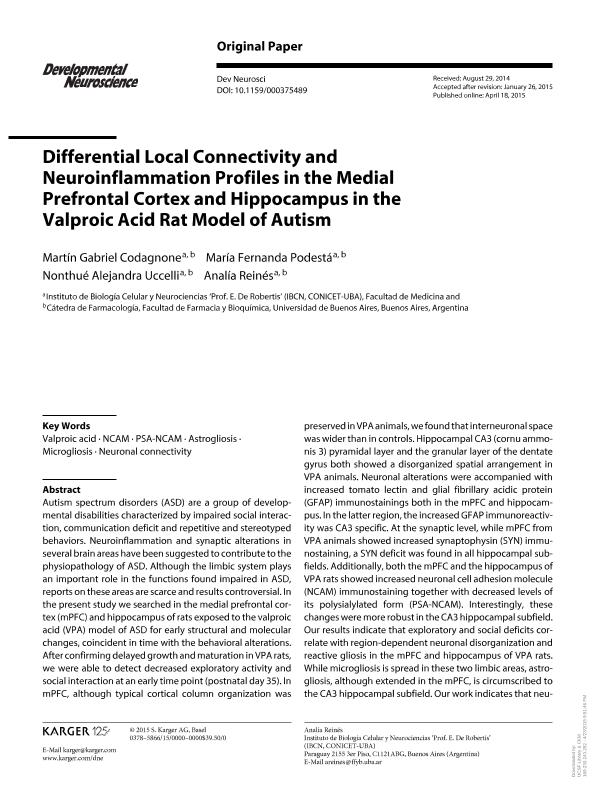Mostrar el registro sencillo del ítem
dc.contributor.author
Codagnone, Martín Gabriel

dc.contributor.author
Podestá, María Fernabda

dc.contributor.author
Uccelli, Nonthué Alejandra

dc.contributor.author
Reines, Analia Gabriela

dc.date.available
2022-12-28T14:31:30Z
dc.date.issued
2015-07
dc.identifier.citation
Codagnone, Martín Gabriel; Podestá, María Fernabda; Uccelli, Nonthué Alejandra; Reines, Analia Gabriela; Differential local connectivity and neuroinflammation profiles in the medial prefrontal cortex and hippocampus in the valproic acid rat model of autism; Karger; Developmental Neuroscience; 37; 3; 7-2015; 215-231
dc.identifier.issn
0378-5866
dc.identifier.uri
http://hdl.handle.net/11336/182710
dc.description.abstract
Autism spectrum disorders (ASD) are a group of developmental disabilities characterized by impaired social interaction, communication deficit and repetitive and stereotyped behaviors. Neuroinflammation and synaptic alterations in several brain areas have been suggested to contribute to the physiopathology of ASD. Although the limbic system plays an important role in the functions found impaired in ASD, reports on these areas are scarce and results controversial. In the present study we searched in the medial prefrontal cortex (mPFC) and hippocampus of rats exposed to the valproic acid (VPA) model of ASD for early structural and molecular changes, coincident in time with the behavioral alterations. After confirming delayed growth and maturation in VPA rats, we were able to detect decreased exploratory activity and social interaction at an early time point (postnatal day 35). In mPFC, although typical cortical column organization was preserved in VPA animals, we found that interneuronal space was wider than in controls. Hippocampal CA3 (cornu ammonis 3) pyramidal layer and the granular layer of the dentate gyrus both showed a disorganized spatial arrangement in VPA animals. Neuronal alterations were accompanied with increased tomato lectin and glial fibrillary acidic protein (GFAP) immunostainings both in the mPFC and hippocampus. In the latter region, the increased GFAP immunoreactivity was CA3 specific. At the synaptic level, while mPFC from VPA animals showed increased synaptophysin (SYN) immunostaining, a SYN deficit was found in all hippocampal subfields. Additionally, both the mPFC and the hippocampus of VPA rats showed increased neuronal cell adhesion molecule (NCAM) immunostaining together with decreased levels of its polysialylated form (PSA-NCAM). Interestingly, these changes were more robust in the CA3 hippocampal subfield. Our results indicate that exploratory and social deficits correlate with region-dependent neuronal disorganization and reactive gliosis in the mPFC and hippocampus of VPA rats. While microgliosis is spread in these two limbic areas, astrogliosis, although extended in the mPFC, is circumscribed to the CA3 hippocampal subfield. Our work indicates that neuroinflammation and synaptic alterations do coexist in VPA rats, making this model suitable for studying novel aspects of neuron-glia interactions. Moreover, it suggests that the mPFC and hippocampus might behave differently in the context of the local hyperconnectivity and synaptic hypotheses of autism.
dc.format
application/pdf
dc.language.iso
eng
dc.publisher
Karger

dc.rights
info:eu-repo/semantics/openAccess
dc.rights.uri
https://creativecommons.org/licenses/by-nc-sa/2.5/ar/
dc.subject
ASTROGLIOSIS
dc.subject
MICROGLIOSIS
dc.subject
NCAM
dc.subject
NEURONAL CONNECTIVITY
dc.subject
PSA-NCAM
dc.subject
VALPROIC ACID
dc.subject.classification
Neurociencias

dc.subject.classification
Medicina Básica

dc.subject.classification
CIENCIAS MÉDICAS Y DE LA SALUD

dc.title
Differential local connectivity and neuroinflammation profiles in the medial prefrontal cortex and hippocampus in the valproic acid rat model of autism
dc.type
info:eu-repo/semantics/article
dc.type
info:ar-repo/semantics/artículo
dc.type
info:eu-repo/semantics/publishedVersion
dc.date.updated
2022-12-27T12:21:18Z
dc.identifier.eissn
1421-9859
dc.journal.volume
37
dc.journal.number
3
dc.journal.pagination
215-231
dc.journal.pais
Suiza

dc.journal.ciudad
Basilea
dc.description.fil
Fil: Codagnone, Martín Gabriel. Consejo Nacional de Investigaciones Científicas y Técnicas. Oficina de Coordinación Administrativa Houssay. Instituto de Biología Celular y Neurociencia "Prof. Eduardo de Robertis". Universidad de Buenos Aires. Facultad de Medicina. Instituto de Biología Celular y Neurociencia; Argentina. Universidad de Buenos Aires. Facultad de Farmacia y Bioquímica. Departamento de Farmacología. Cátedra de Farmacología; Argentina
dc.description.fil
Fil: Podestá, María Fernabda. Consejo Nacional de Investigaciones Científicas y Técnicas. Oficina de Coordinación Administrativa Houssay. Instituto de Biología Celular y Neurociencia "Prof. Eduardo de Robertis". Universidad de Buenos Aires. Facultad de Medicina. Instituto de Biología Celular y Neurociencia; Argentina. Universidad de Buenos Aires. Facultad de Farmacia y Bioquímica. Departamento de Farmacología. Cátedra de Farmacología; Argentina
dc.description.fil
Fil: Uccelli, Nonthué Alejandra. Universidad de Buenos Aires. Facultad de Farmacia y Bioquímica. Departamento de Farmacología. Cátedra de Farmacología; Argentina. Consejo Nacional de Investigaciones Científicas y Técnicas. Oficina de Coordinación Administrativa Houssay. Instituto de Biología Celular y Neurociencia "Prof. Eduardo de Robertis". Universidad de Buenos Aires. Facultad de Medicina. Instituto de Biología Celular y Neurociencia; Argentina
dc.description.fil
Fil: Reines, Analia Gabriela. Consejo Nacional de Investigaciones Científicas y Técnicas. Oficina de Coordinación Administrativa Houssay. Instituto de Biología Celular y Neurociencia "Prof. Eduardo de Robertis". Universidad de Buenos Aires. Facultad de Medicina. Instituto de Biología Celular y Neurociencia; Argentina. Universidad de Buenos Aires. Facultad de Farmacia y Bioquímica. Departamento de Farmacología. Cátedra de Farmacología; Argentina
dc.journal.title
Developmental Neuroscience

dc.relation.alternativeid
info:eu-repo/semantics/altIdentifier/doi/http://dx.doi.org/10.1159/000375489
dc.relation.alternativeid
info:eu-repo/semantics/altIdentifier/url/https://www.karger.com/Article/Pdf/375489
Archivos asociados
